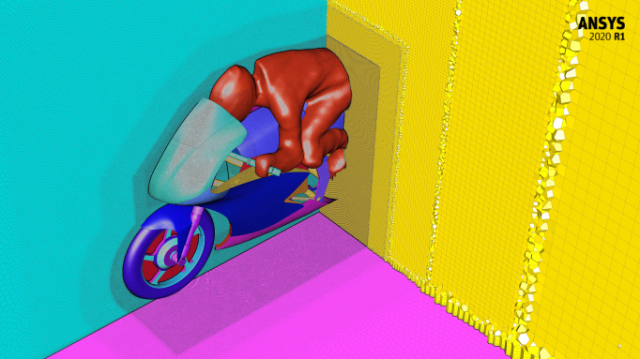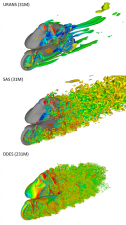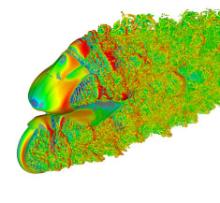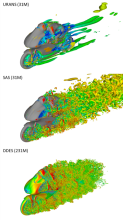Numerical analyzes, colloquially called simulations, are now not only a synonym for innovative economy, but most of all they decide about the advantage on the market. – Their use resembles working in a virtual laboratory, where without the cost of building a prototype, you can verify the designers’ ideas. Numerical simulations using high-power computers accelerate calculations up to several hundred times compared to standard workstations. The Świerk IT Center (CIŚ) at NCBJ offers such opportunities. They were presented on the example of a simulation of air flow around an electric motorcycle designed by students.
One of the industries that is particularly interested in simulations is automotive. The rapid transformation currently taking place, especially in the context of propulsion units; from combustion to electric, it creates a niche for innovative solutions. Perun also follows this trend (https://skap-pw.pl/index.php/pojazdy/nasze-pojazdy?id=16) – Moto Student electric motorcycle. The vehicle is entirely designed and manufactured by members of the Students’ Vehicle Aerodynamics Club (SKAP) at the Warsaw University of Technology with the support of the resources of Symkom and the National Centre for Nuclear Research.
Virtual motorcycle prototype
Perun is an original machine, the result of the vision of a young generation of Polish engineers. It was not made on the drawing board, and its performance was not established post-factum, i. e. during testing. It is shaped using tools that allow you to create its virtual counterpart. Computational Fluid Dynamics, as the method is called, has been used for years in the design of vehicle aerodynamics. Its accuracy depends largely on the computing power of the computer used for this purpose. What distinguishes this project is the use of the enormous computing power of the Świerk IT Center, thanks to which it was possible to achieve very high accuracy of the simulation.
„The purpose of the simulations was to optimize the shape of the vehicle details, taking into account the driver’s position” – explains Eng. Krzysztof Wiński from SKAP. „The minimization of aerodynamic drag translates into an increase in the speed and range of the machine. The most desirable, i. e. perfectly streamlined shape is one that does not cause turbulence in the surrounding air while moving. The geometry of the motorcycle with the rider is an extremely complicated aerodynamically shape, which minimizing its aerodynamic drag is a very demanding task. If we want to cope with them, we must observe the sources and evolution of the turbulences. To capture them during the analysis, we enclose our virtual vehicle in a certain volume, representing the surrounding air, which we then tightly fill with much smaller cells (so-called control volumes), often several orders of length smaller than the tested object itself. This is how the so-called computing grid."
Fig. 1. A computational grid generated in the Mosaic technology consisting of 231 million elements
This procedure, called space discretization, allows the use of numerical methods to solve complex equations describing the flow. The smaller the elements of the mesh, the more accurately we can predict how the flow will behave. Ideally, it should be dense enough to capture even the slightest turbulence in the flow. „Most often, due to hardware limitations, we cannot afford it and it is necessary to adopt some simplifications” – explained Dr Eng. Adam Piechna (Symkom). „There are methods that track certain average values that tell us about turbulence – these methods are called RANS methods and have relatively low hardware requirements. Another approach is to divide the vortex spectrum into two areas: large and small vortices. The former are tracked directly using the constructed numerical grid, while the latter are modeled in a simplified manner. The denser the mesh used, the easier we can track smaller and smaller vortices, but it is associated with increased computation time and the need to engage more computing power. This approach is called Large Eddy Simulation (LES). In the calculation of external aerodynamics, hybrid methods are also successfully used, combining some advantages of both solutions, one of the most popular is the DDES. ”
Calculations in 15 hours instead of several months
Fig. 2 shows the visualization of the motorcycle flow obtained with the use of various turbulence models. One of the methods of presenting the effects of calculations is to show the outlines of vortex structures, which give an overview of their shape and size. „The differences result from the use of methods of different accuracy, starting from the simplest, ie RANS, through SAS (Scale Adaptive Simulation – a more advanced version of RANS) up to DDES” – explains MSc. Piotr Prusiński from the NCBJ Complex Systems Research Department. „RANS and SAS were run on a grid consisting of a trifle of 31 million cells. Nevertheless, SAS allows you to see much smaller structures. The DDES calculation required the creation of a computational grid that met a number of additional criteria; its size was 231 million cells, which in engineering practice is a very large mesh „– the scientist emphasizes. „The simulation, showing the oscillations occurring during 0.01 s of the experimental time, lasted about 15 hours with the use of 1400 physical computational cores of the CIŚ! Even on a very powerful workstation, these simulations would take several months. In the presented simulation, it was possible to take into account the subtle aspects of turbulence modeling very accurately. "
The presented simulations are extremely computationally expensive, but they reflect the reality very well. To do them, you need huge hardware resources, dedicated software and specialists who know how to use them in an effective way. They are the result of cooperation of experts in the field of numerical fluid mechanics and high-power computer technology. The presented analyzes were possible thanks to the use of the advanced ANSYS engineering tools package provided by Symkom.
The presented application is just the tip of the iceberg of using CFD methods. Scientists and engineers from the National Centre for Nuclear Research have prepared the environment and created a workshop where reactors, rockets, racing motorcycles and everyday objects can be designed using the latest simulation technologies. The workshop, which has so far been within the reach of the largest companies, is now available at your fingertips!
„Why a motorcycle in NCBJ?” – asks Piotr Prusiński. „Because the speed of calculating large problems is our domain! All those who want to learn more about the possibilities offered by the NCBJ infrastructure of computers with high computing power, are invited to a presentation during the free Symkom CONFERENCE event on November 19.”
Registration for the presentation: https://bit.ly/3EsdkVz.
Video: Optimization of the shape of the details of a motorcycle created for the SKAP scientific club in cooperation with experts from the National Centre for Nuclear Research and the Symkom company.










